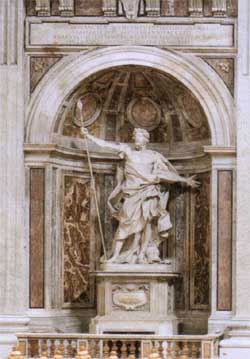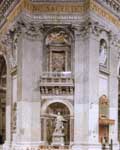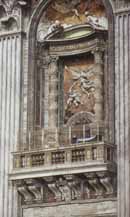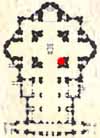| Grottoes
Vatican City Colonnade Saints Floorplan #2 |
| Altars
Monuments The History |
| Related
Items St Helen Statue Veronica Statue St Andrew Statue |
 |
St. Longinus was the Roman centurion who pierced the side of Christ with a lance. He is said to have converted to Christianity after experiencing the darkness after Christ's death. St. Luke tells us that the centurion "gave praise to God", and exclaimed, "Truly this was an upright man." (Luke 23:47) What was believed to be the Holy Lance of Longinus, was given to Innocent VIII in 1492. |
 |
 |
From: 'Guide to
Saint Peter's Basilica'
Beneath the loggias of the relics Bernini created huge niches which hold
four colossal statues, almost 10 m. high, which are associated with the
relics. In the first pier on the right is the statue of St. Longinus,
the soldier who pierced the side of Jesus, from which "blood and water"
flowed. It was carved by Bernini in 1643 from four blocks of marble.
The dome above the papal altar is supported by four gigantic piers, 45 m. high with a perimeter of 71 m., started by Bramante and completed by Michelangelo. In 1624 Urban VIII commissioned Bernini to create four loggias in these piers. They are called the "Loggias of the Relics". Each is protected by a balustrade and adorned with two columns decorated with vine leaves and splendid bas-reliefs referring to the four "major relics". In fact, Urban VIII wanted him to carve out four niches in these loggias, where he then had placed the precious relics, formally kept but not properly preserved in the basilica.
The relics were: several fragments of the Cross of Jesus, which were found in the Roman churches of Santa Croce in Gerusalemme and Santa Anastasia, which in 1629 Urban VIII wished to be given to St. Peter's Basilica and placed in the pier of St. Helen; a scrap of material, showing the imprint of the face of a bearded man which had been brought by the crusades from Jerusalem to Rome and was already venerated before the 12th century; a fragment of the lance which was said to have belonged to St. Longinus and which Sultan Bajazet, the son of Mohomet II, had presented to Pope Innocent VIII (1492); St. Andrew's head, brought to Venice by Thomas Palaiolagos and donated to Pius II (1460).
The relics are now no longer in their original site, but the three relics
of Our Lord's Passion are kept in the chapel above the statue of St. Veronica,
and displayed to the people on the fifth Sunday in Lent. The relic of
St. Andrew's head however, was sent by Paul VI as a gift to the Church
of St. Andrew in Patras and a sign of friendship with the Greek Orthodox
Church.
Other Sources
Like his predecessors, Innocent wished to stop the Turkish advance, but
he succeeded by means other than the crusade he originally planned. Djem,
brother and rival of Sultan Beyazid II, was being held captive by Pierre
d’Aubusson; the pope saw that if he held over the sultan the threat of
supporting Djem’s pretensions, Beyazid would come to terms. Beyazid (1490)
agreed to leave Europe at peace if the pope kept Djem captive. He agreed
in 1489 to hold Sultan Bayezid II's brother prisoner in Rome in exchange
for a yearly ransom and the Holy Lance of St. Longinus, the spear thrust
into Christ's body at the crucifixion.

